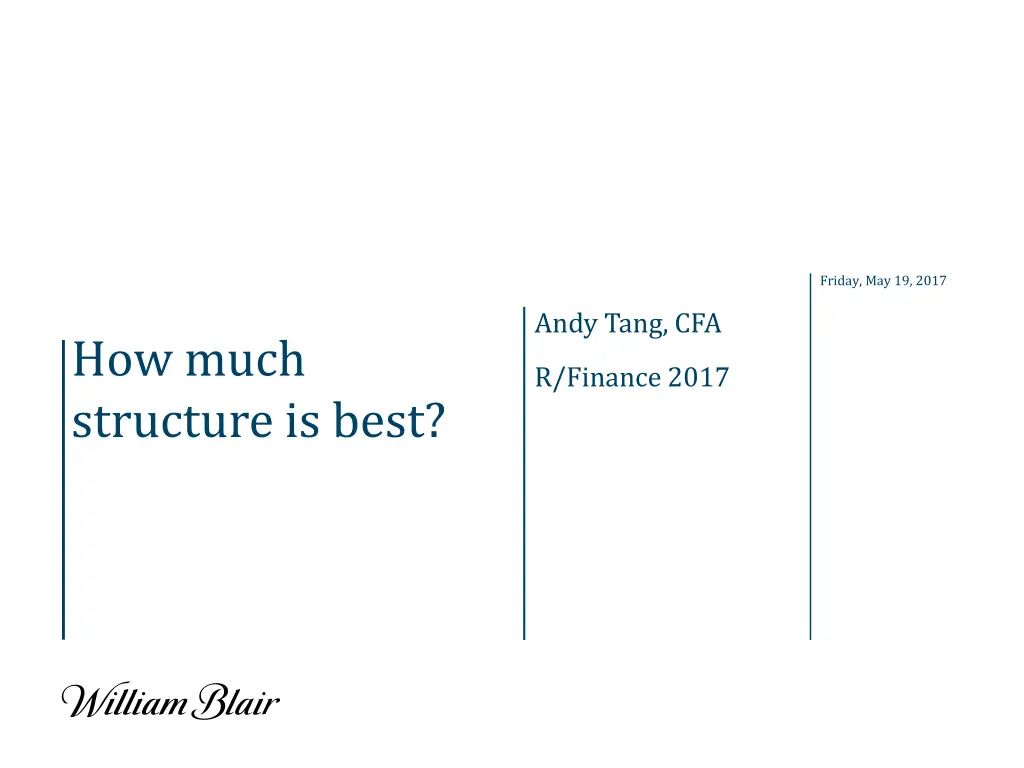
Optimal Structure for Covariance Matrix Estimation in Financial Analysis
Explore the importance of finding the right balance in structuring covariance matrices for financial analysis. Learn about different methods, including fully unstructured and conditionally structured approaches, to address issues like curse of dimensionality and misspecification error. Discover how region and sector effects during global crises can be analyzed using dynamic graphic models. Find out why having the right amount of structure is crucial for forecast accuracy in financial modeling.
Download Presentation

Please find below an Image/Link to download the presentation.
The content on the website is provided AS IS for your information and personal use only. It may not be sold, licensed, or shared on other websites without obtaining consent from the author. If you encounter any issues during the download, it is possible that the publisher has removed the file from their server.
You are allowed to download the files provided on this website for personal or commercial use, subject to the condition that they are used lawfully. All files are the property of their respective owners.
The content on the website is provided AS IS for your information and personal use only. It may not be sold, licensed, or shared on other websites without obtaining consent from the author.
E N D
Presentation Transcript
Friday, May 19, 2017 Andy Tang, CFA How much structure is best? R/Finance 2017
How to estimate a covariance matrix? 1. Fully unstructured 2. Fully unstructured R R?= X X ??+ ?? ????+ ? ??,???,?, R R?= ?? ? r r?,?r r?,? = ?? ? r r?,?r r?,? = ? ??,???,? ??,? ??,?, ? ? Examples: Sample, Shrinkage, EWMA Examples: BARRA, GO-GARCH 2
How to estimate a covariance matrix? 1. Fully unstructured 2. Fully unstructured Curse of dimensionality! Misspecification error! 3
Method 3: Conditionally structured Example: Dynamic Graphic Model (DGM) R R?= ????+ ??,?? ? 0, ?; ??= ?? 1+ ??,?? ? 0,??, ? ?|?? 1,?? = ???????,?? 4
Method 3: Region effects during European Debt Crisis DGM + FF3 with100+ stocks from MSCI-ACWX Node size ERC weights Edge size 1/correlation 5
Method 3: Sector effects during Global Financial Crisis DGM + FF3 with100+ stocks from MSCI-ACWX Node size ERC weights Edge size 1/correlation 6
Method 3: Structureness through time The expected number of edges is 360 out of 6650 or 5% of structureness! 7% First Greek Bailout 6% Euro QE Starts Lehman Collapse 5% China Slowdown 4% Dec-04 Dec-06 Dec-08 Dec-10 Dec-12 Dec-14 Dec-16 7
Forecast Accuracy Conclusion: Structureness? not too much, not too little, just in the middle! Error Ratio Sample Shrink EWMA DGM GO-GARCH BARRA MSFE MSTE More Less Structure Structure 8
Thank you Comments/Questions? atang@williamblair.com 9
